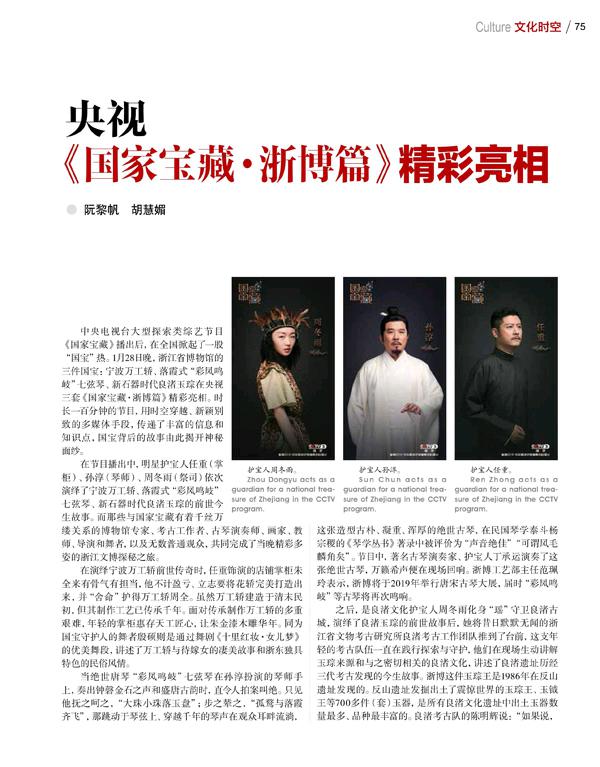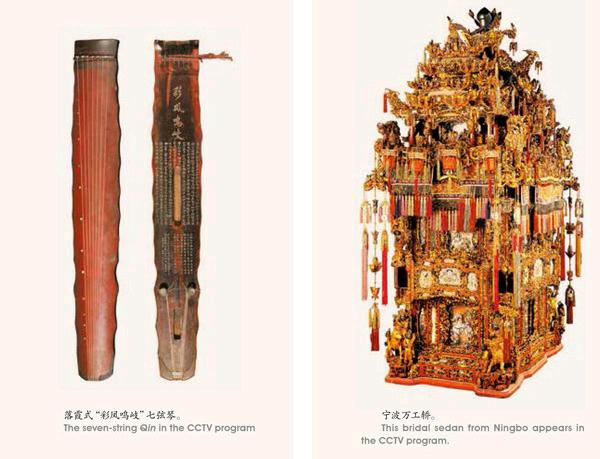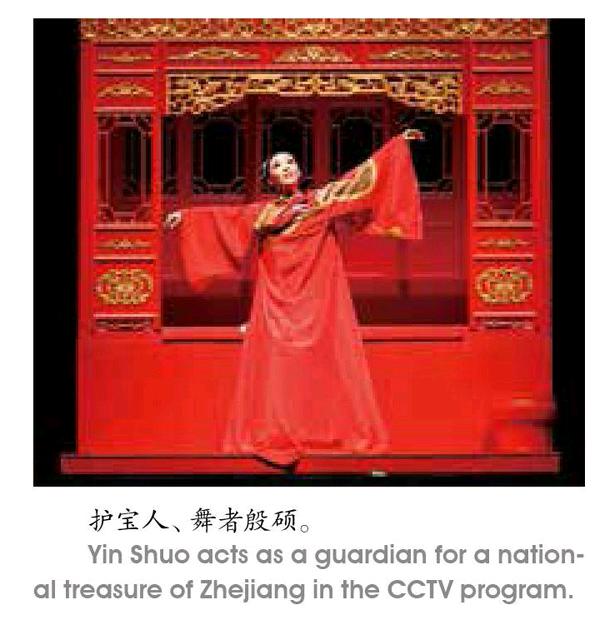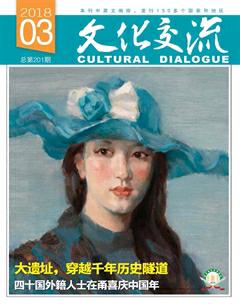央视《国家宝藏?浙博篇》精彩亮相
阮黎帆+胡慧媚
中央电视台大型探索类综艺节目《国家宝藏》播出后,在全国掀起了一股“国宝”热。1月28日晚,浙江省博物馆的三件国宝:宁波万工轿、落霞式“彩凤鸣岐”七弦琴、新石器时代良渚玉琮在央视三套《国家宝藏·浙博篇》精彩亮相。时长一百分钟的节目,用时空穿越、新颖别致的多媒体手段,传递了丰富的信息和知识点,国宝背后的故事由此揭开神秘面纱。

在节目播出中,明星护宝人任重(掌柜)、孙淳(琴师)、周冬雨(祭司)依次演绎了宁波万工轿、落霞式“彩凤鸣岐”七弦琴、新石器时代良渚玉琮的前世今生故事。而那些与国家宝藏有着千丝万缕关系的博物馆专家、考古工作者、古琴演奏师、画家、教师、导演和舞者,以及无数普通观众,共同完成了当晚精彩多姿的浙江文博探秘之旅。
在演绎宁波万工轿前世传奇时,任重饰演的店铺掌柜朱全来有骨气有担当,他不计盈亏、立志要将花轿完美打造出来,并“舍命”护得万工轿周全。虽然万工轿建造于清末民初,但其制作工艺已传承千年。面对传承制作万工轿的多重艰难,年轻的掌柜惠存天工匠心,让朱金漆木雕华年。同为国宝守护人的舞者殷硕则是通过舞剧《十里红妆·女儿梦》的优美舞段,讲述了万工轿与待嫁女的凄美故事和浙东独具特色的民俗风情。
当绝世唐琴“彩凤鸣岐”七弦琴在孙淳扮演的琴师手上,奏出钟磬金石之声和盛唐古韵时,直令人拍案叫绝。只见他抚之呵之,“大珠小珠落玉盘”;步之辇之,“孤鹜与落霞齐飞”,那跳动于琴弦上、穿越千年的琴声在观众耳畔流淌,这张造型古朴、凝重、浑厚的绝世古琴,在民国琴学泰斗杨宗稷的《琴学丛书》著录中被评价为“声音绝佳”“可谓凤毛麟角矣”。节目中,著名古琴演奏家、护宝人丁承运演奏了这张绝世古琴,万籁希声便在现场回响。浙博工艺部主任范珮玲表示,浙博将于2019年举行唐宋古琴大展,届时“彩凤鸣岐”等古琴将再次鸣响。

之后,是良渚文化护宝人周冬雨化身“瑶”守卫良渚古城,演绎了良渚玉琮的前世故事后,她将昔日默默无闻的浙江省文物考古研究所良渚考古工作团队推到了台前,这支年轻的考古队伍一直在践行探索与守护,他们在现场生动讲解玉琮来源和与之密切相关的良渚文化,讲述了良渚遗址历经三代考古发现的今生故事。浙博这件玉琮王是1986年在反山遗址发现的。反山遗址发掘出土了震惊世界的玉琮王、玉钺王等700多件(套)玉器,是所有良渚文化遗址中出土玉器数量最多、品种最丰富的。良渚考古队的陈明辉说:“如果说,1000年前看北京,2000年前看西安,那么,5000年前就要看杭州良渚了。”引来现场掌声一片。
据代表浙博参加《国家宝藏》节目录制的副馆长蔡琴介绍,浙江省博物馆的馆藏文物及标本有十万余件,要从中选出三件宝物委实很难。好在2009年浙江省博物馆80周年庆之际,推出过“十大镇馆之宝”评选活动,经公众投票和专家评选最终产生“十大镇馆之宝”。其实,十万件藏品件件是宝贝,“十大镇馆之宝”件件都可以入选。其中,《富春山居图·剩山图卷》、越王者旨於睗剑等,都有传奇故事。因此,选择亮相的这三件文物,经历了艰难的“断舍离”过程。因为选出的文物不仅要代表浙江地域文明,还要综合考虑9家博物馆27件文物不能有雷同(编者注:在第一季《国家宝藏》节目亮相的共有9家著名博物馆,共同点都是国家级博物馆),选择难度可想而知。所以,浙博最终选择了新石器时代良渚文化玉琮、唐落霞式彩凤鸣岐七弦琴、清末民初宁波万工轿。
蔡琴说,浙博馆藏的玉琮王是独一无二的,既是良渚文化的典型代表,也是中华五千年文明的实证,良渚文化更是无可取代。目前传世的古琴中,唐琴的数量不会超过20张,彩凤鸣岐七弦琴来自于唐代制琴第一人雷威,流传坎坷曲折,故事性强,还是琴学泰斗杨宗稷最珍爱的三张琴之一,琴腹上有“民国古琴第一人”杨宗稷的题写。来自清末民初的万工轿,是节目中最年轻的国宝,虽然级别不高,但在浙博的每次评选中都是最受欢迎的一件文物。这三件宝贝的入选,也与该节目对文物类别的平衡和综合考虑有关,如辽宁省博物馆入选的文物中有两件是书画作品,还有故宫博物院的《千里江山图》,故知名度最高的《富春山居图》(剩山图卷)这次就没能入选;同时,上海博物馆、河南博物院、湖北省博物馆都有重量级的青铜器入选,考虑到青铜器在节目中的比重,春秋战国时期的伎乐铜屋也不在入选之列。蔡琴认为:“文物没有高下,只有不同,文物的价值也不能用一把尺子来衡量,只是每次选择的角度不同而已”。

浙博负责人表示“期待更多的年轻人观看这档节目,也希望更多的观众走进浙博看实物。”据了解,2017年浙博推出了300余场文博活动、30场左右的临时展览,接待观众近370万人次。2018年将推出大展“越地宝藏——100件文物讲述浙江故事”,届时浙江本省的国宝将会在浙江省博物馆再次亮相。
新石器时代良渚文化玉琮
新石器时代
通高8.9厘米、上射径17.1—17.6厘米、下射径16.5—17.5厘米、孔外径5厘米、孔内径3.8厘米
整器重约6500克,形体宽阔硕大,纹饰独特繁缛,为良渚文化玉琮之首。器型外方内圆,上大下小,中间对钻圆孔。琮体四面直槽内上下各琢刻一完整的神人兽面图像,神人头戴羽冠,骑跨在一神兽上。整体图案采用浅浮雕和线刻技法雕琢而成。在呈角尺形的凸面上,纹饰以转角为中轴线向两侧展开,每节琢刻一组象征性的神人兽面图案,这种简化的人兽组合结构,是良渚文化玉琮纹饰的基本特征。兽面的两侧各浅浮雕一变形夸张的鸟纹,而鸟也是通天的灵物。琮是良渚玉器中最神秘又最富代表性的器物,其功用说法不一,多数学者认为它是一种祭祀的法器。此玉琮是目前发现的良渚玉琮中最大、最重、做工最精美的一件,通稱“琮王”。不仅如此,与之同出的玉钺、玉权杖等在诸多良渚玉器中都是最庄重且独一无二的,说明它们无疑是已拉开文明乐章的良渚文化的王权之象征。endprint

落霞式“彩鳳鸣岐”七弦琴
唐
通长124.8厘米、额宽16.3厘米、肩宽18.8厘米、尾宽12.5厘米、厚5.4厘米
“彩凤鸣岐”七弦琴,落霞式,造型古朴,典雅,背面有冰裂断和小流水断,美丽而别致。此琴是杨宗稷“半百琴斋”中最珍爱的琴,并著录于《琴学丛书》。在民国古琴界就有着超凡的地位,为琴界苦苦追寻的绝品。“彩凤鸣岐”琴,虽历经沧桑,却仍能弹奏出悦耳动听的琴曲,更让人称奇的是,音质绝佳,极富感染力,在存世唐琴中音质属上乘,也恰好印证了杨宗稷对它的高度评价:“声音绝佳”“可谓凤毛麟角矣”。传世唐琴,是不可多得的珍宝。“唐琴第一推雷公,蜀中九雷独称雄”。唐代蜀地是制琴的主要基地,而最为著名的就是四川雷氏,雷家世代造琴,以雷威最为著名。“彩凤鸣岐”琴正是雷威的杰作,因而是一件举世无双的珍宝。
宁波万工轿
清末民初
长150厘米,宽90厘米,高275厘米
此轿是清末民初宁波式花轿,因制造时耗费了一万多个工时,故称“万工轿”。此轿需八个人抬,又称“八抬大轿”。花轿根据雕饰人物的多寡及工艺水平而分为三等,此轿属头等轿,是现存最豪华的一顶花轿。它采用榫卯结构联结,没有一枚钉子,由几百片可拆卸的花板组成,没有轿门,迎亲时有专门的拆轿师傅跟随在迎亲的队伍里负责拆卸,使新娘子方便出入。花轿木质雕花,朱漆铺底饰以金箔贴花,远远望去金碧辉煌,犹如一座微型的宫殿。轿上采用圆雕、浮雕、透雕等三种工艺手法进行装饰,雕有250个人物,花鸟虫兽无数,所以宁波人也称它为“百子轿”。除了天官赐福、麒麟送子、魁星点斗、独占鳌头等吉祥主题外,还有《浣纱记》《天水关》《铁弓缘》《水浒传》《西厢记》《荆钗记》《拾玉镯》等戏曲场景,有的地方还辅以镜片玻璃画,每一幅画也都是一个古典名剧片段。

CCTV is running a program featuring the countrys top-class antique treasures. On the evening of January 28, the program presented three national treasures from Zhejiang.
The three national relics are a bridal sedan made in Ningbo, a seven-string made in 714, the second year of the Kaiyuan Period of the Tang Dynasty (618-907), and a jade unearthed from the ruins of Liangzhu, a culture of Neolithic Age more than 5,000 years ago.
The bridal sedan is something a little bit new in comparison with the other two. The sedan was probably made in the last years of the Qing Dynasty (1644-1911) or even in the early years of the Republic of China (1911-1949). The tradition of the bridal sedan and the crafts required for such a sedan making project go back to more than 1,000 years ago Ningbo in eastern part of Zhejiang Province. What makes this bridal sedan stand out is that more than 10,000 work-days were invested in the making.
The sedan is installed with hundreds of woodcarving components painted in gold and red colors. The woodcarving components present hundreds of human figures in scenes of traditional opera plays. Auspicious animals and plants are also presented in these woodcarving pieces. Not a single nail is used. It usually takes half a day to uninstall the sedan, but it takes a whole day to install all the components. The sedan weighs over 200 kilograms. According to literature, it takes eight men to carry the sedan. If the journey is long, a backup team is needed. Two craftsmen walk with the sedan to make sure it goes through narrow and low spaces safely. If necessary, the craftsmen can uninstall some tall parts on the spot if the space is too low, and install the parts back after the bottleneck space.endprint
The seven-string shown in the program from Zhejiang Museum is one of twenty extantmade in the Tang Dynasty. It was made by Lei Wei, a member of the Lei family in Sichuan Province, celebrated for-making in history. It came into the hands of Yang Zongji, a master of the 20th century. In the Republic years it was widely recognized as one of the best . And it is indeed one of the best extant instruments of Tang. On the program, Ding Chengyun played a music piece on the . Zhejiang Museum plans to hold a exhibition of the Tang and the Song in 2019. This Qin and other Qin are scheduled to be on the show.
The jade displayed on the program was unearthed in 1986 at the site of Fanshan, one of the numerous sites of Liangzhu Culture in the suburb of Hangzhou. Over 700 pieces and sets of jade artifacts came out of that excavation in 1986. is a unique jade piece. In form, it is a tube with a circular inner section and a square outer section. Most scholars believe that the object was used in rituals. comes in various sizes. The piece that appeared in the program is the biggest. The piece is 8.9 cm tall and weighs 6.5 kilograms. It is also known as the King of jade . On the four sides of the square outer section are carved half-human- half-animal images.
In a media interview, Cai Qin, associate curator of Zhejiang Museum who served as the narrator to introduce the three treasures to the nation, said that the museum has a large collection of over 100,000 pieces and many of them are national treasures. It was a huge challenge to select three only. Fortunately, the general public and experts decided upon a list of top ten pieces of Zhejiang Museum in 2009 in commemoration of the 80th birthday of the museum. This narrowed down the choices. In order to avoid similarity in presentations of 27 selected pieces from nine national-class museums in the first-season of the television program, Zhejiang eventually picked the three out of the top ten.
The television program aims to bring the antiques to the young generation. This is also the aim of Zhejiang Museum. In 2017, the museum held over 300 cultural events and 30 temporary exhibitions, attracting over 3.7 million visitors. In 2018, the museum is going to launch an exhibition titled.endprint

